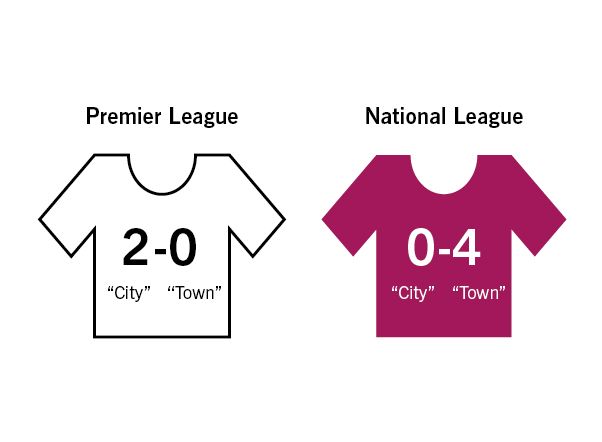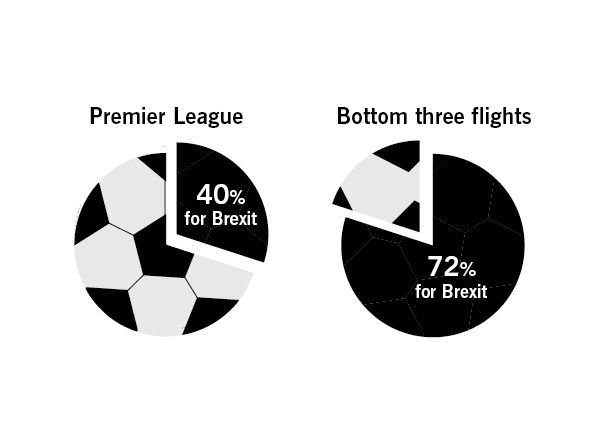If we're being honest, we should probably start by saying that football grounds don't really explain the election result. But stick with us—because they do tell you quite a lot about Britain's electoral divide.
The table shows the five top football divisions in England and Wales, starting with the Premier League and going down to the National League. The main colour marking—red, blue or whatever—shows the political party that holds the constituency in which you can find the club's ground, along with an indication of whether the majority vote in that constituency was for Leave or Remain in the Brexit referendum in 2016.
Premier League grounds are overwhelmingly in Labour-held constituencies which voted Remain. Once you drop into the Championship, the Labour dominance continues, but with the majority of grounds in Leave-voting constituencies. By League One, the Labour dominance has gone and grounds are mainly in Leave-voting seats. This remains true for League Two and the National League. In the Premier League, 75 per cent of clubs are found in Labour seats; by the National League, the figure is just 25 per cent. In the Premier League, 70 per cent of grounds are in Remain-voting constituencies; by the National League, 67 per cent are in Leave-voting constituencies.
[su_box title="The table in full"][su_image_carousel source="media: 91767,91769,91771,91772,91773" crop="none"] Hover to navigate through each league.¹[/su_box]When we've done this exercise before, someone always jokingly suggests that this means that if you want your football club to be successful, you need to vote Labour and Remain. Just in case it's not already blindingly obvious (it should be…), that's not the causal link here. Premier League clubs are mostly in big cities, and big cities largely return Labour MPs and voted Remain. As you move down the leagues, you get smaller cities and towns, which are more likely to be Conservative and/or Leave-voting.
Indeed, since everyone is talking about the electoral importance of towns at the moment, note that in the top two divisions there are just two clubs with the word "Town" in their title (and none in the Premier League), compared to eight with "City" in their title. Whereas in the bottom three divisions, there are 14 "Town"s, and five "City"s.
[su_box title="City v Town"]

We've underlined the seats that changed hands on 12th December. There were 13, predominantly in the lower leagues, all but one going from Labour to Conservative. Elections are not won or lost in the sort of constituencies that host Premier League or Championship clubs. Just two changed hands in the top two divisions. These were Burnley (Burnley FC, obviously) and Wolverhampton South West (Wolves, equally obviously).
By contrast, five clubs in League One saw their home constituency change hands, along with three in both League Two and the National League. We've included Bury here, despite their expulsion from the English Football League (because we're sentimental) and Chorley (a constituency which is now held by the speaker, instead of Labour). All but one of these were in Leave-voting constituencies.
The football club in the most Remain-voting constituency? Bristol Rovers, in Bristol West (79 per cent Remain). The club in the most Leave-voting constituency? Port Vale, in Stoke-on-Trent North (72 per cent Leave). Prior to 12th December, Labour held both, which summed up its strategic dilemma over Brexit. After 12th December, Labour only held the former, which summed up how well it dealt with that dilemma.
We're used to some of the standard objections. For one thing, this exercise is based on a club's ground; it does not claim to say anything about the political leanings of a club's supporters. There was a survey of the latter (here, if you're interested), which showed these could diverge; Chelsea may be the only Premier League club based in a Conservative seat where a majority voted Remain—but the survey found Chelsea supporters to be the most pro-Leave of any Premier League club.
Plus, we know some people will quibble over the grounds. For example, why is Brighton and Hove Albion marked as red, when Caroline Lucas is Britain's only Green MP? Answer: because their ground isn't in Lucas's seat. It's in Brighton Kemptown (currently Labour). In fact, it sits close to the border of three constituencies; the car park is in Conservative-held Lewes.
We're especially grateful that this election saw the Conservatives take the seats of Great Grimsby, Scunthorpe and Peterborough, because this has long been the source of confusion—as the grounds of Grimsby, Scunthorpe and Peterborough aren’t in these three seats, which is why they are not marked here as having changed hands.
Similarly, why are Liverpool and Everton (the two grounds are in the same constituency) shown as Leave, when Liverpool voted to Remain in 2016? Answer: because that's the result for Liverpool as a whole; the estimates for the constituency of Liverpool Walton are that it voted narrowly to Leave. The same applies, for example, to Reading and both Birmingham clubs.
[su_box title="Continents apart"]

People are also confused occasionally by clubs playing at different grounds. To take a subject close to one of the author's hearts, Bristol Rovers have variously played at Eastville (Bristol North West, currently Labour), then at Twerton Park (Bath, currently Lib Dem), and are now at the Memorial Ground (Bristol West, Labour). For Coventry City, who are currently playing in Birmingham, we've used St Andrew's. (Were they to move back to the Ricoh Arena, they'd still be in a Labour seat, but a Leave-voting one).
And no, we don't include Scotland here. It's almost entirely a big block of SNP yellow. Life's too short, even for us.
[su_divider]¹ Clubs based in seats won by the Tories are blue; Labour, red; Lib Dem, yellow; and, Speaker Hoyle’s Chorley is in grey.
* indicates a 2019 Conservative gain
Note: Grounds are not always in the seat with the most obvious name. Bury is included despite recent expulsion from the Football League.












